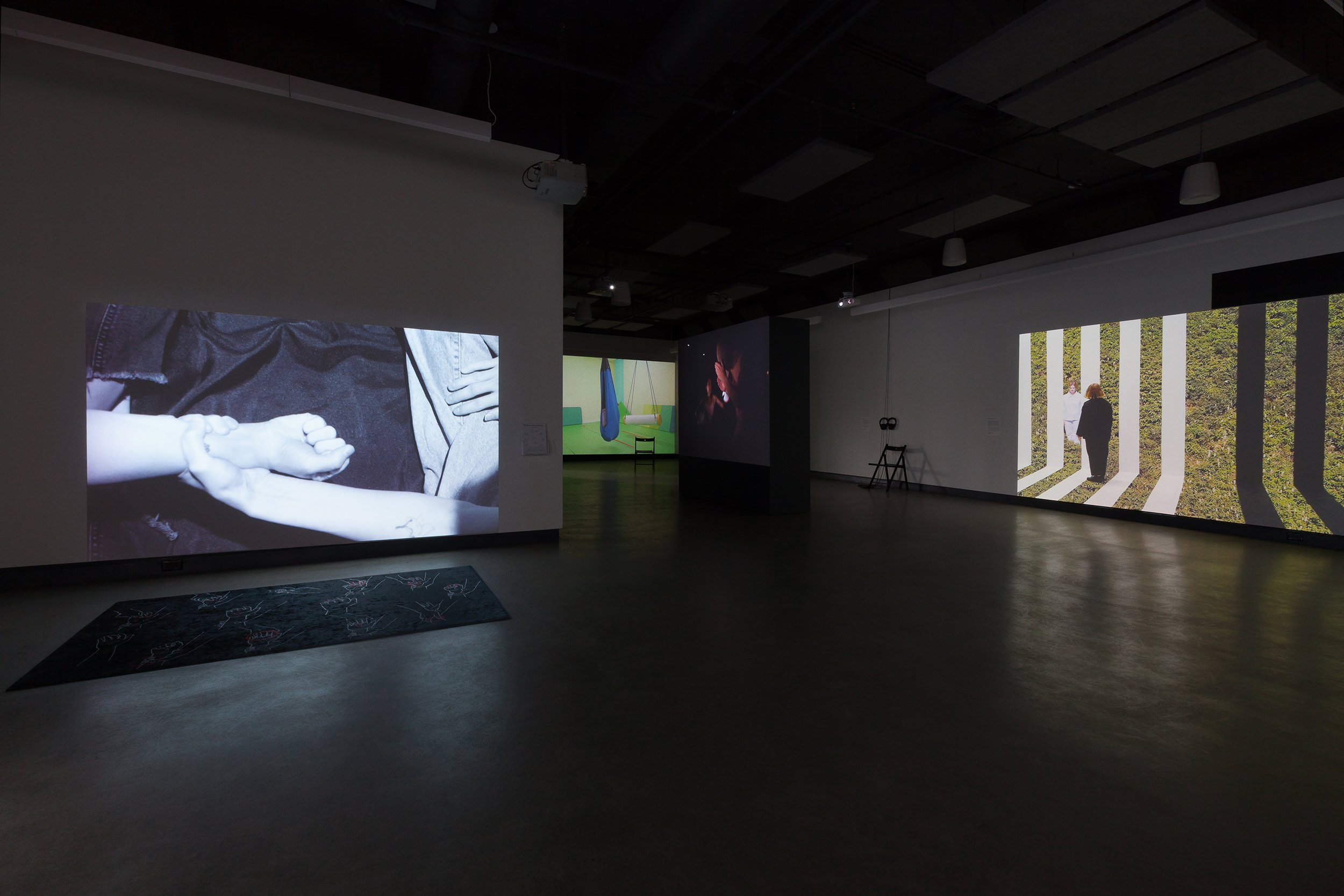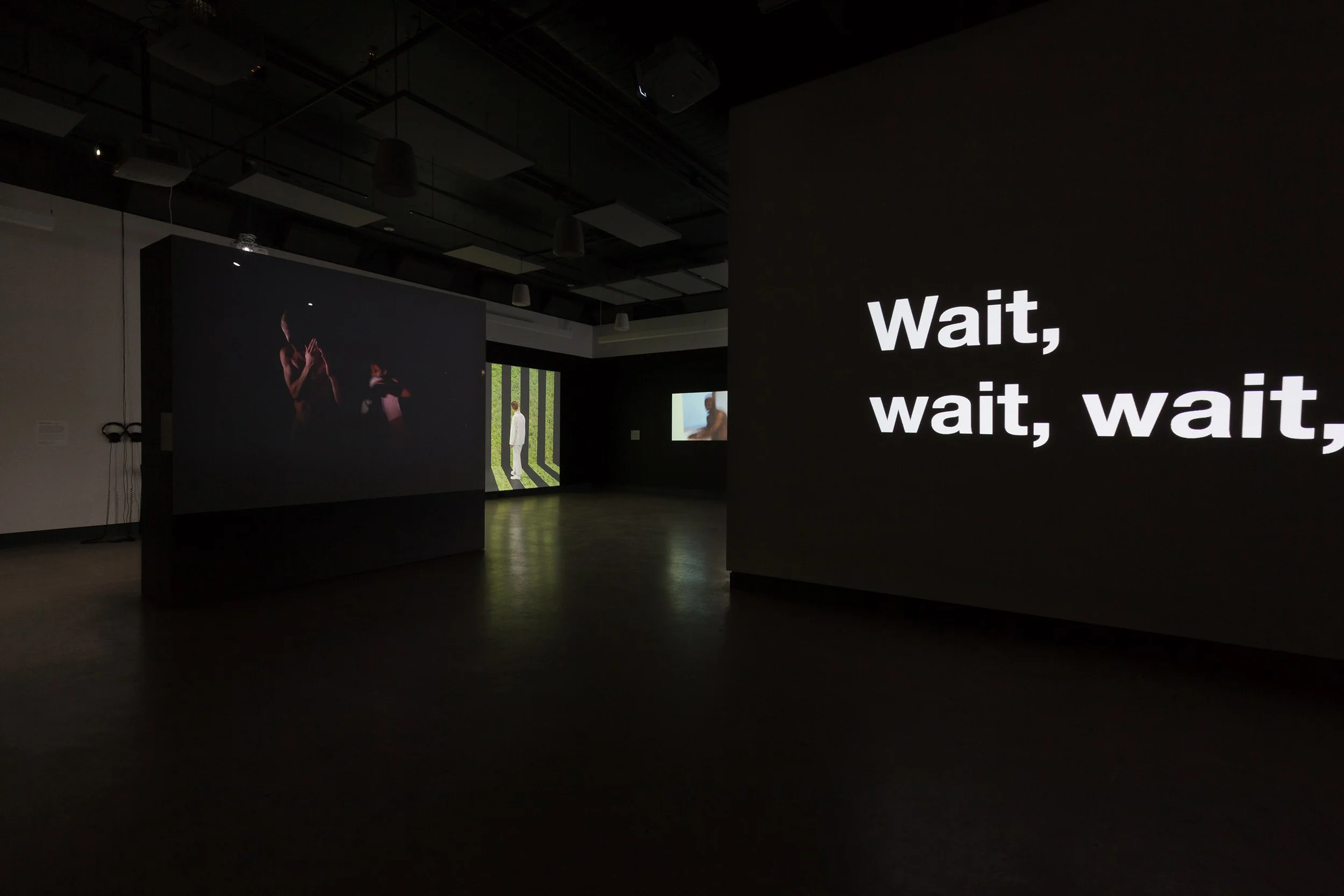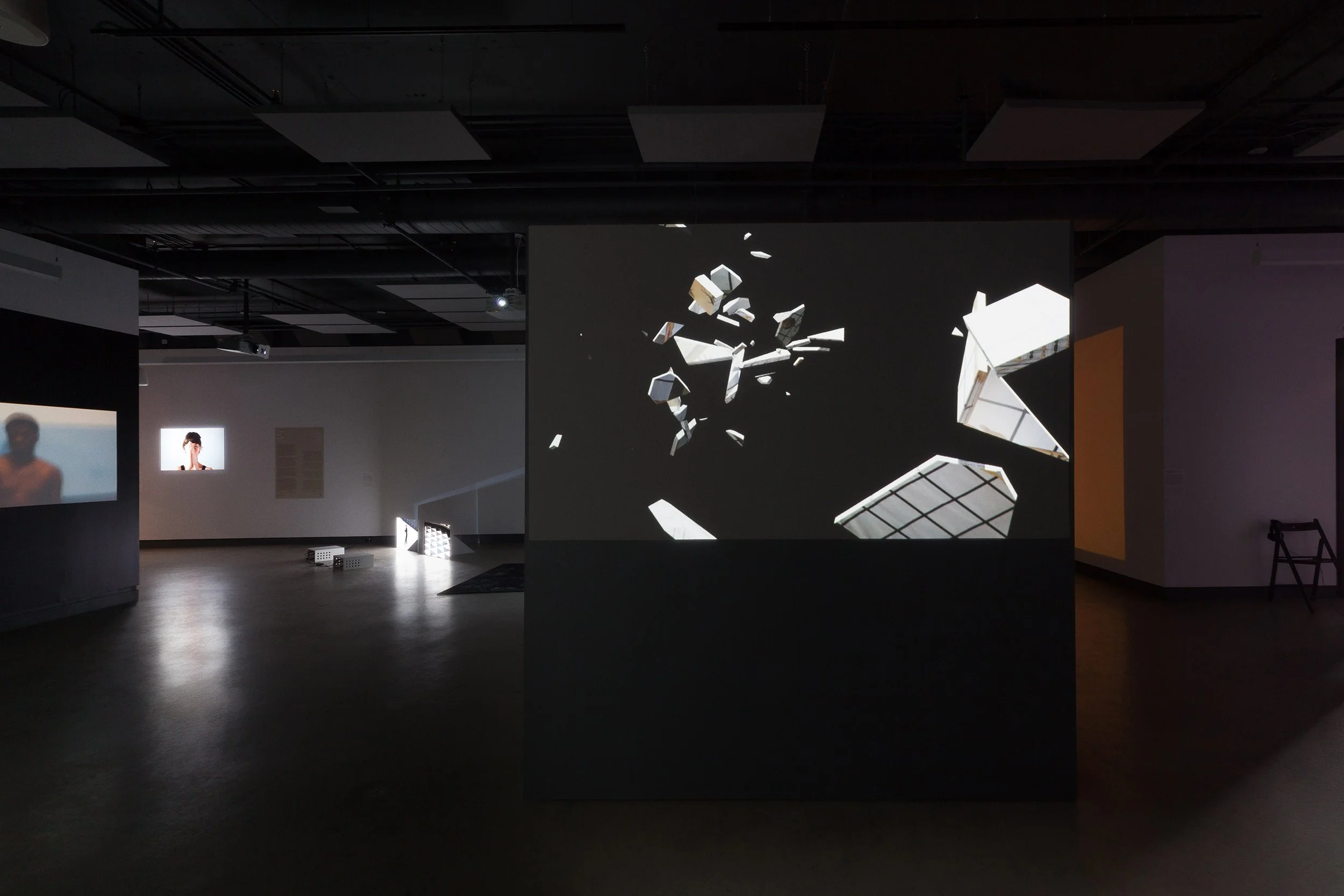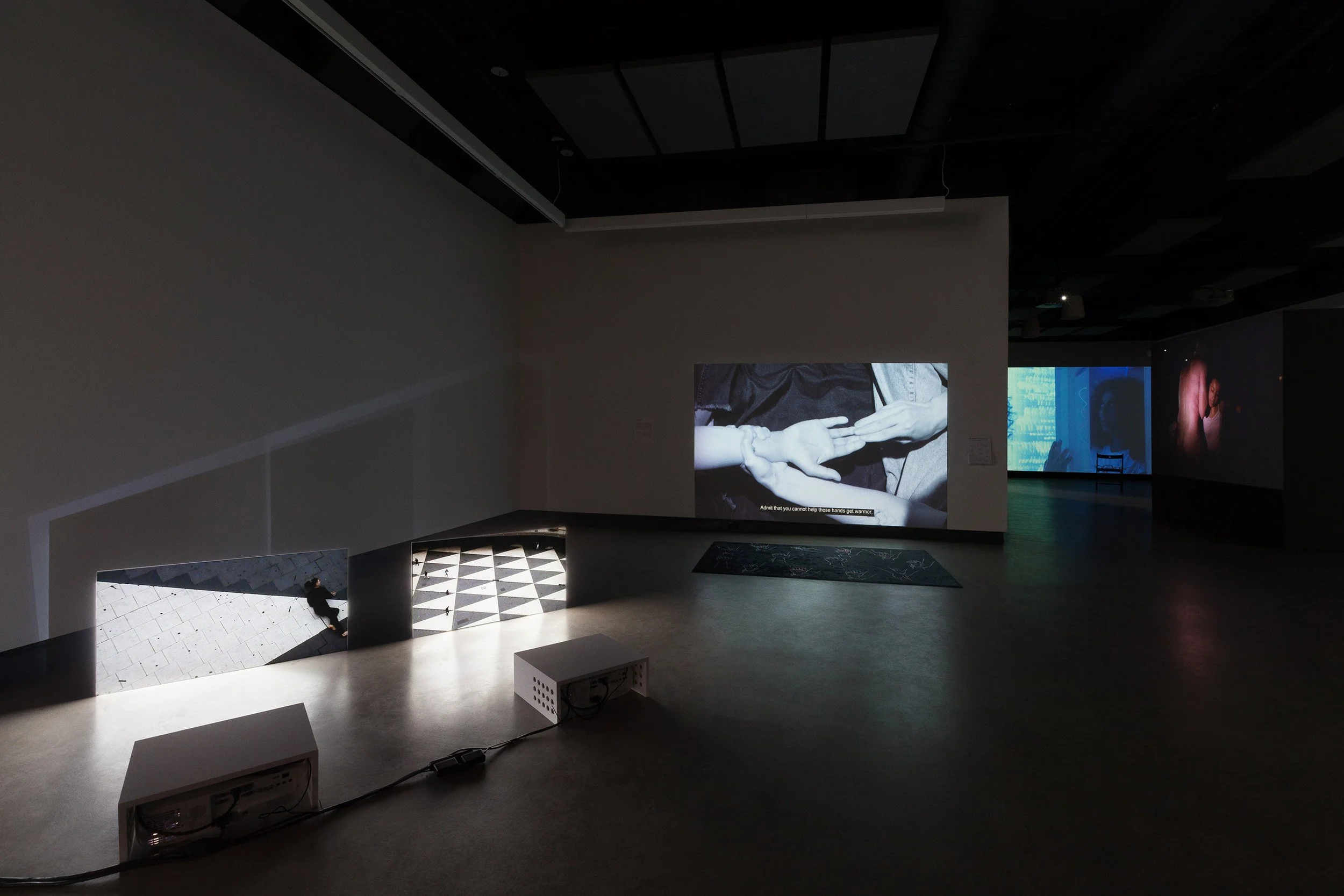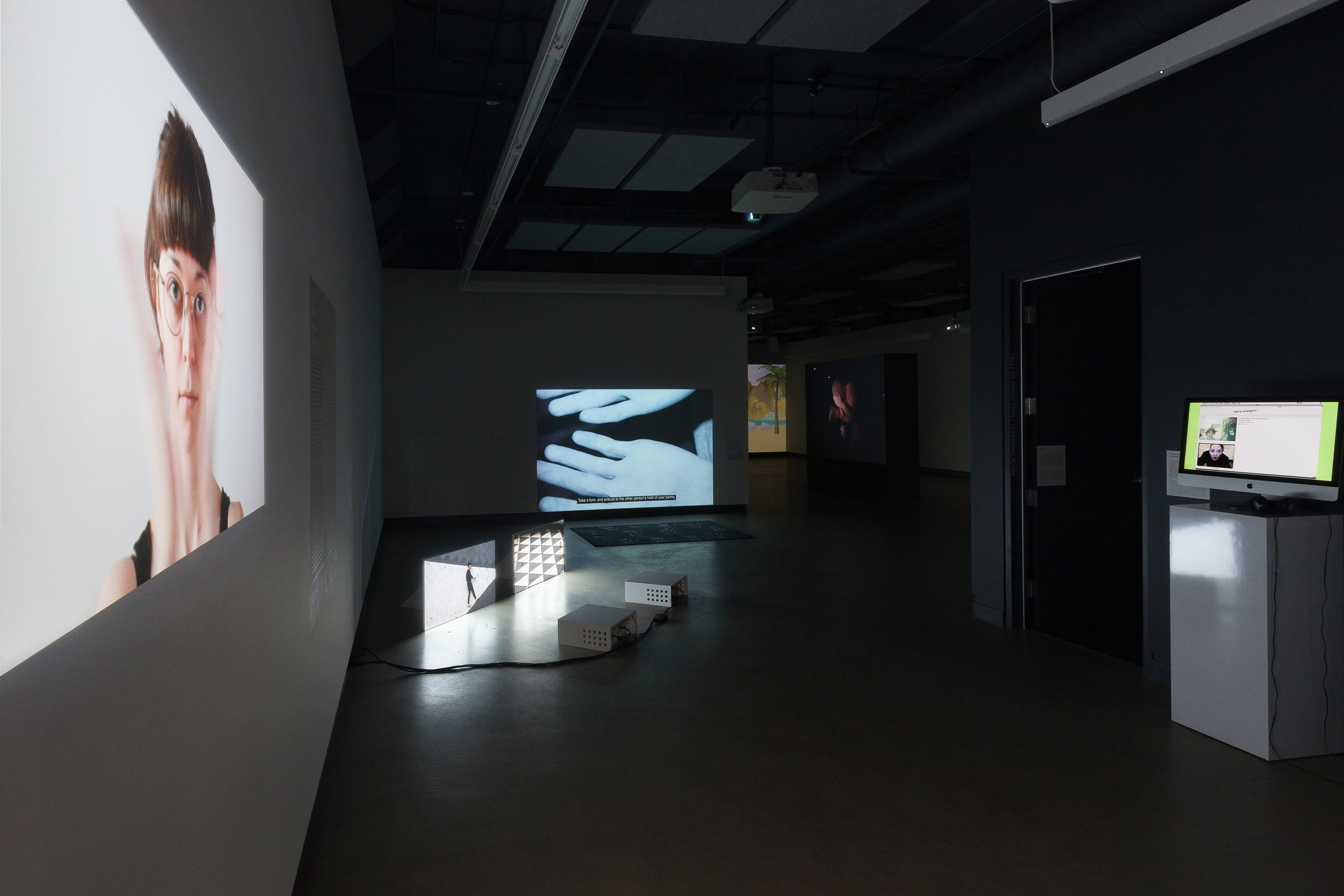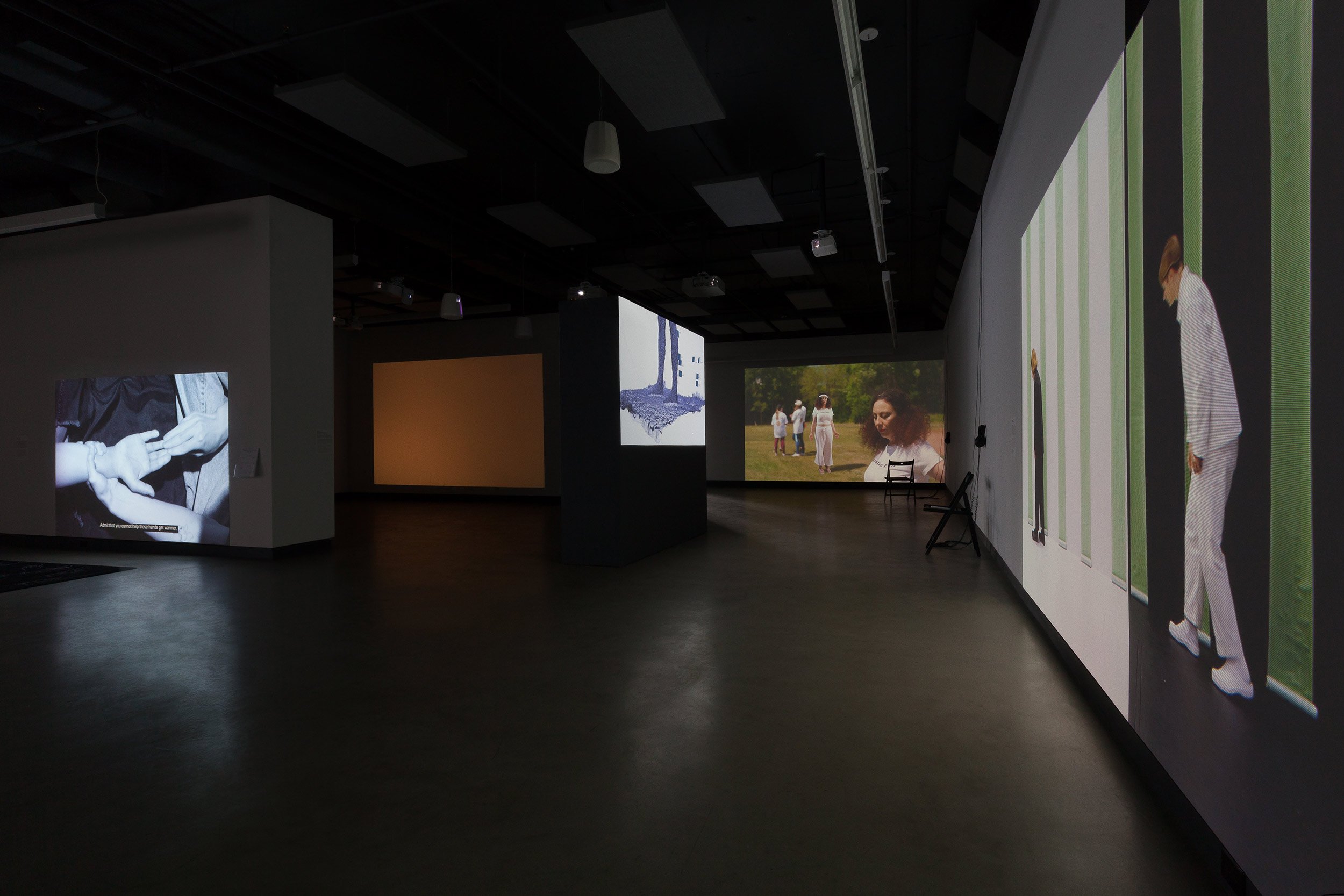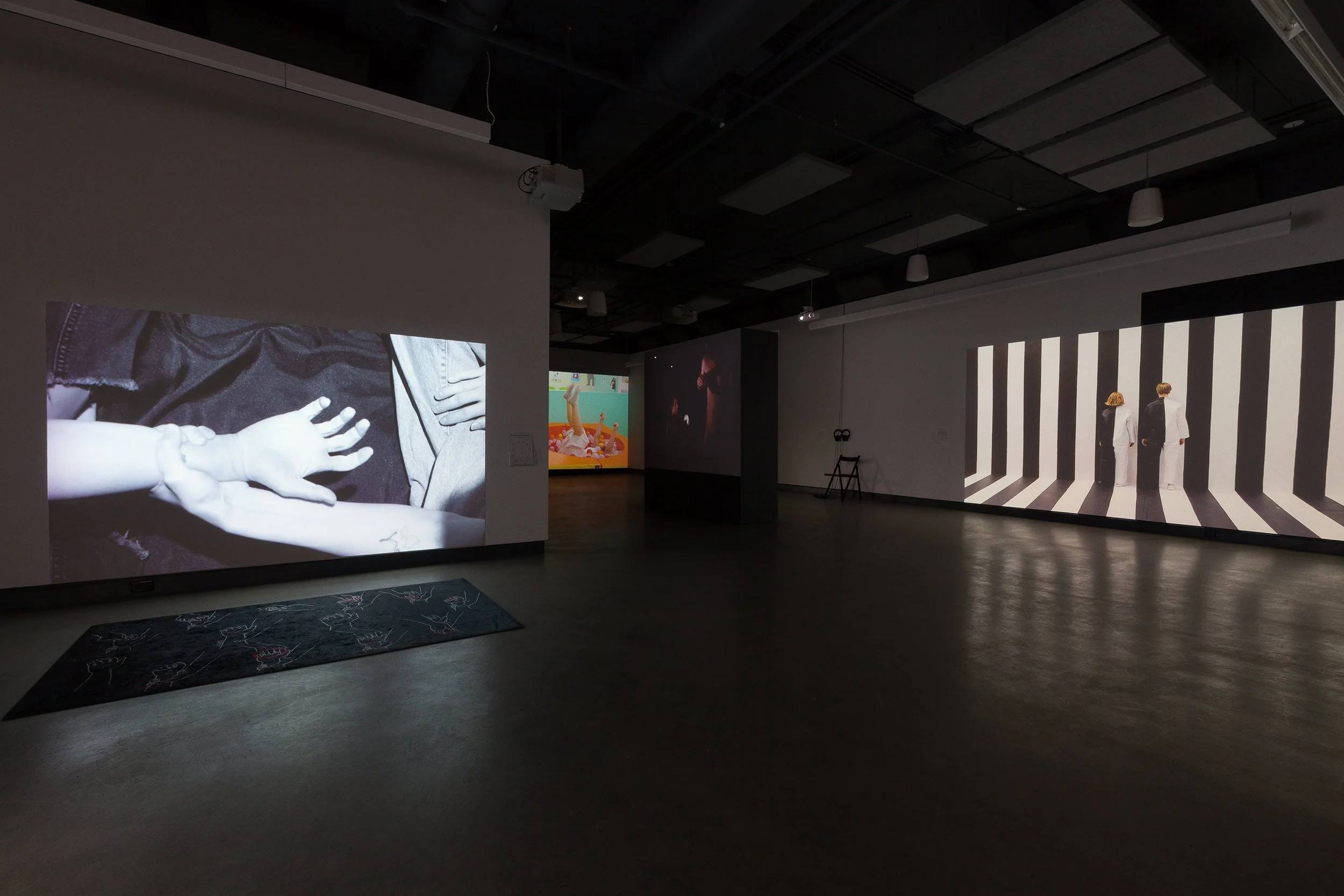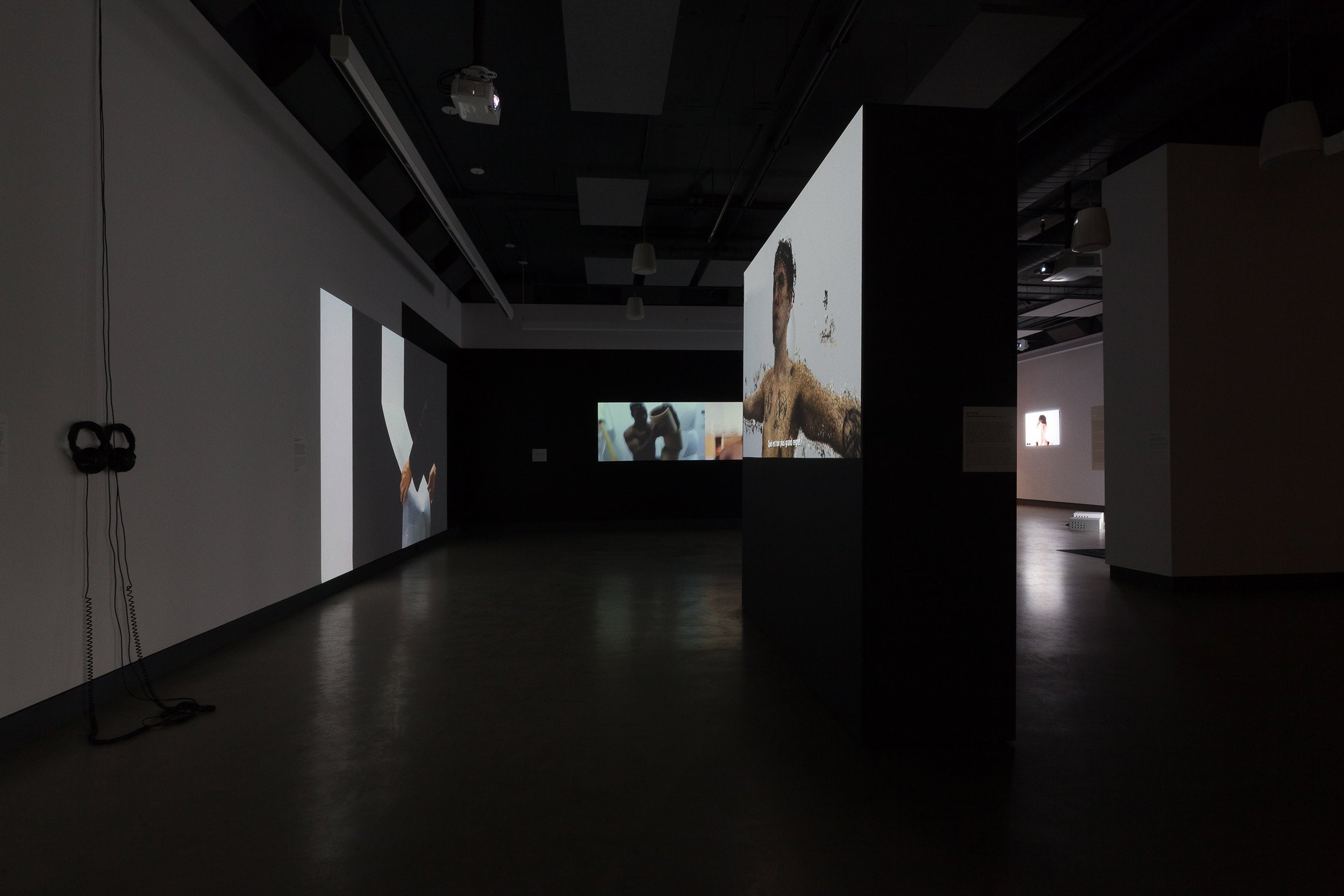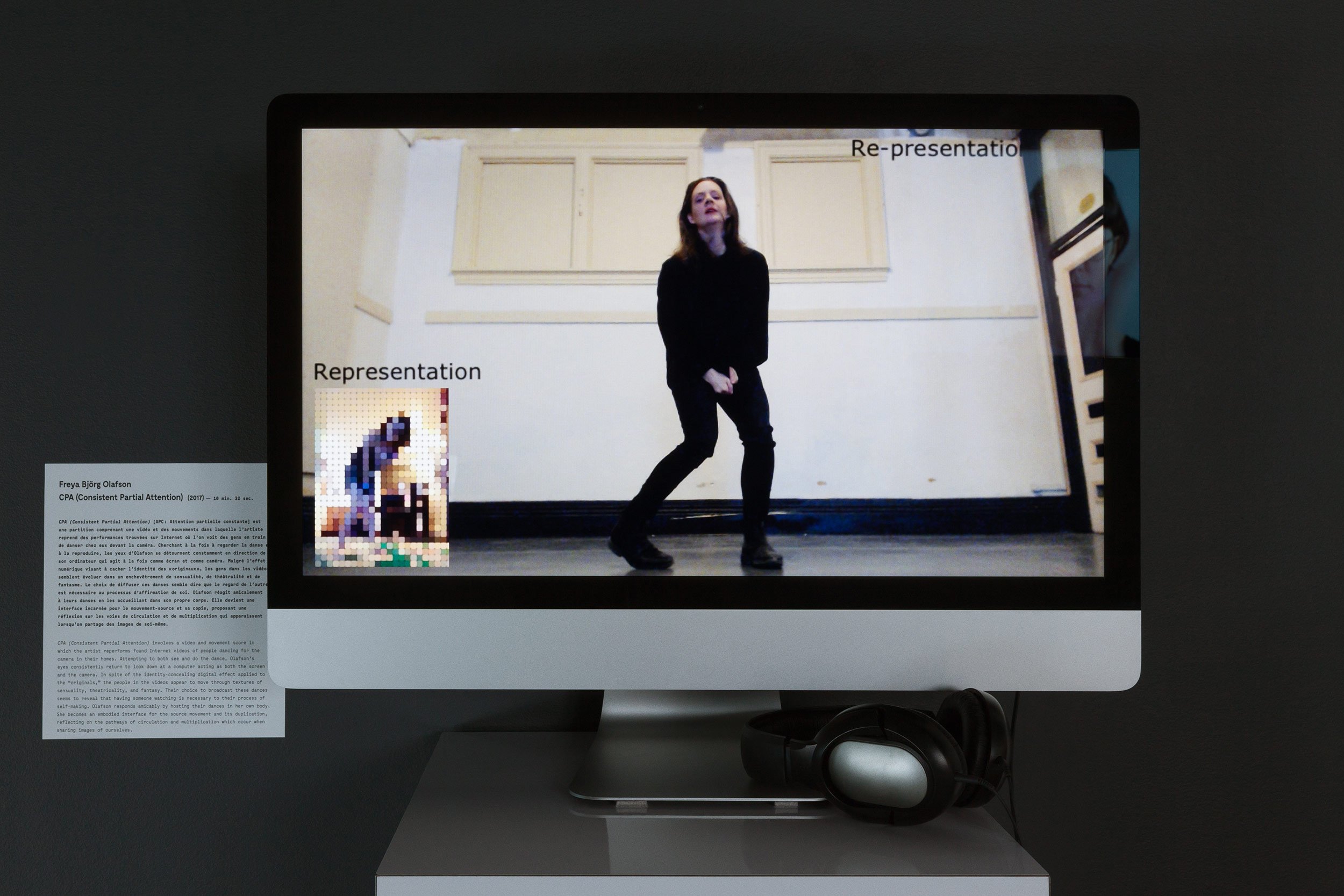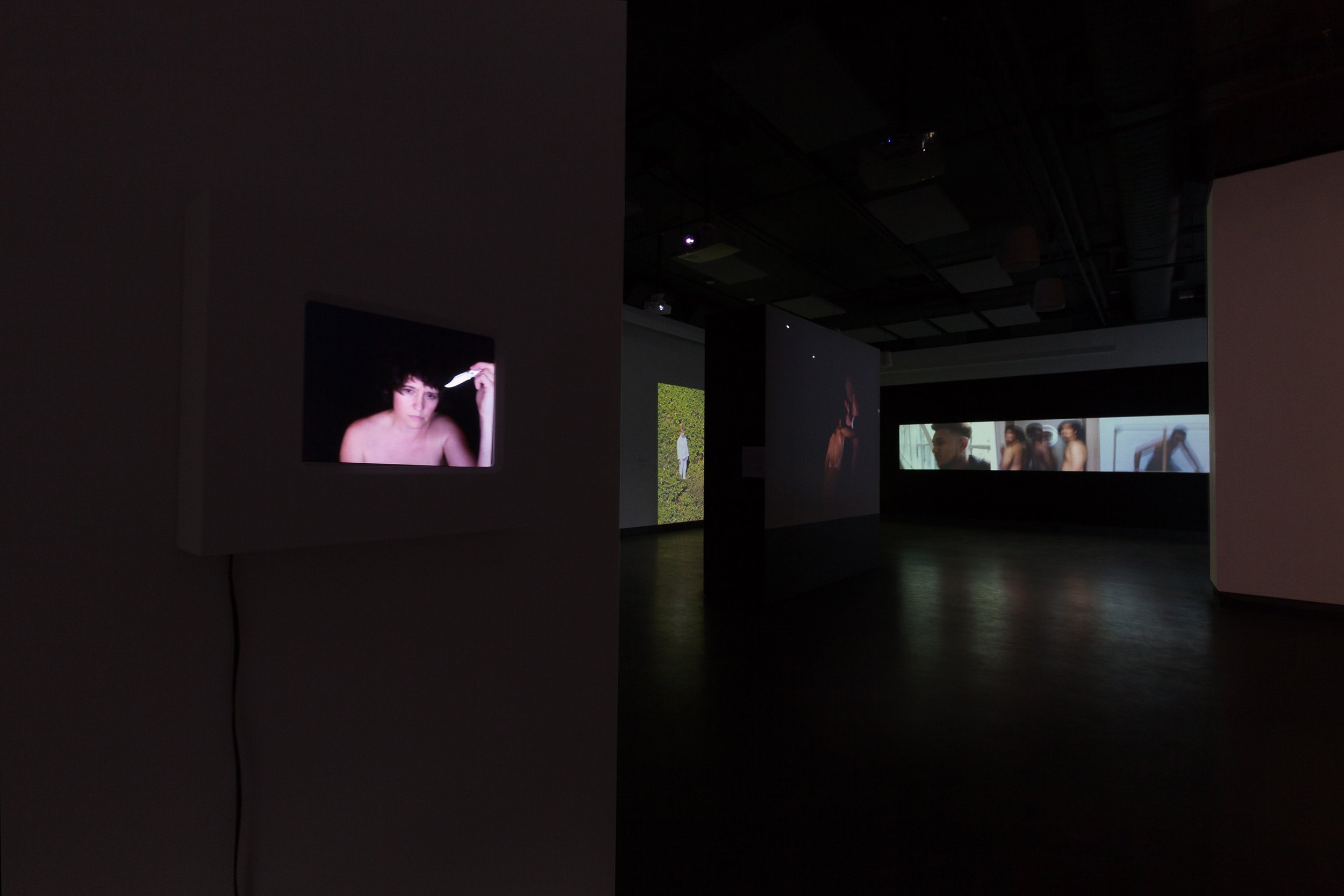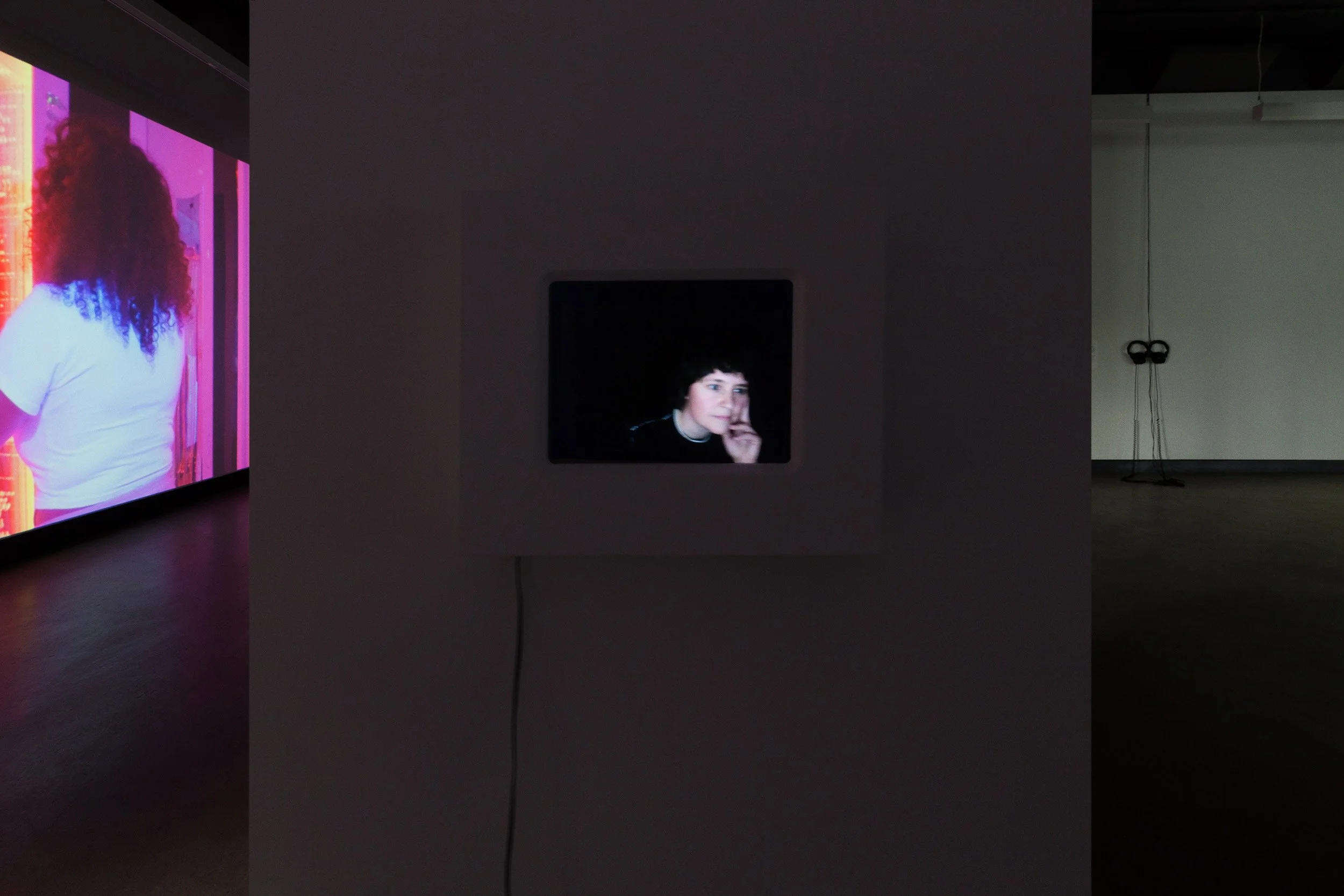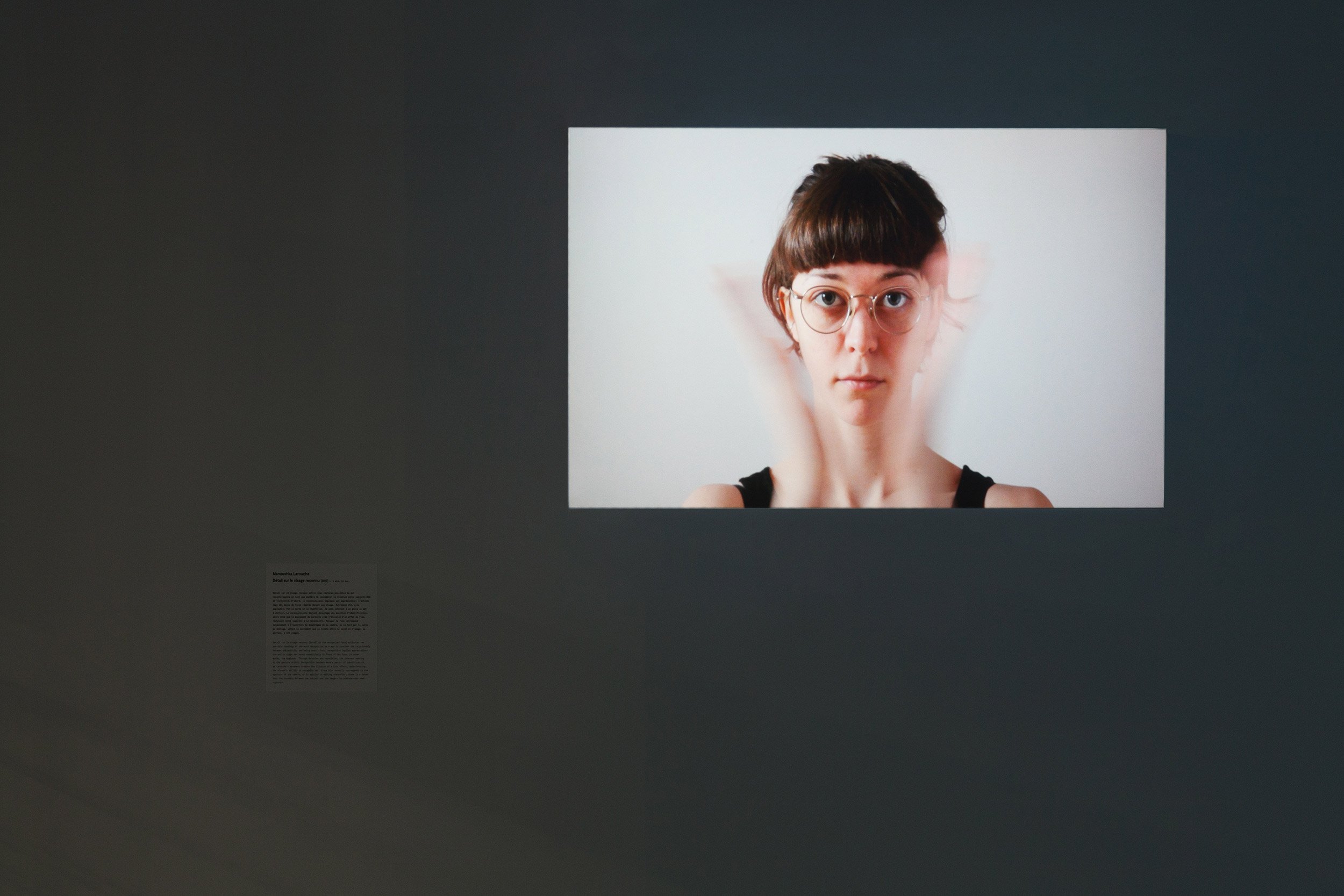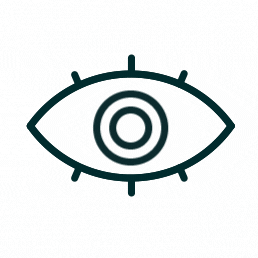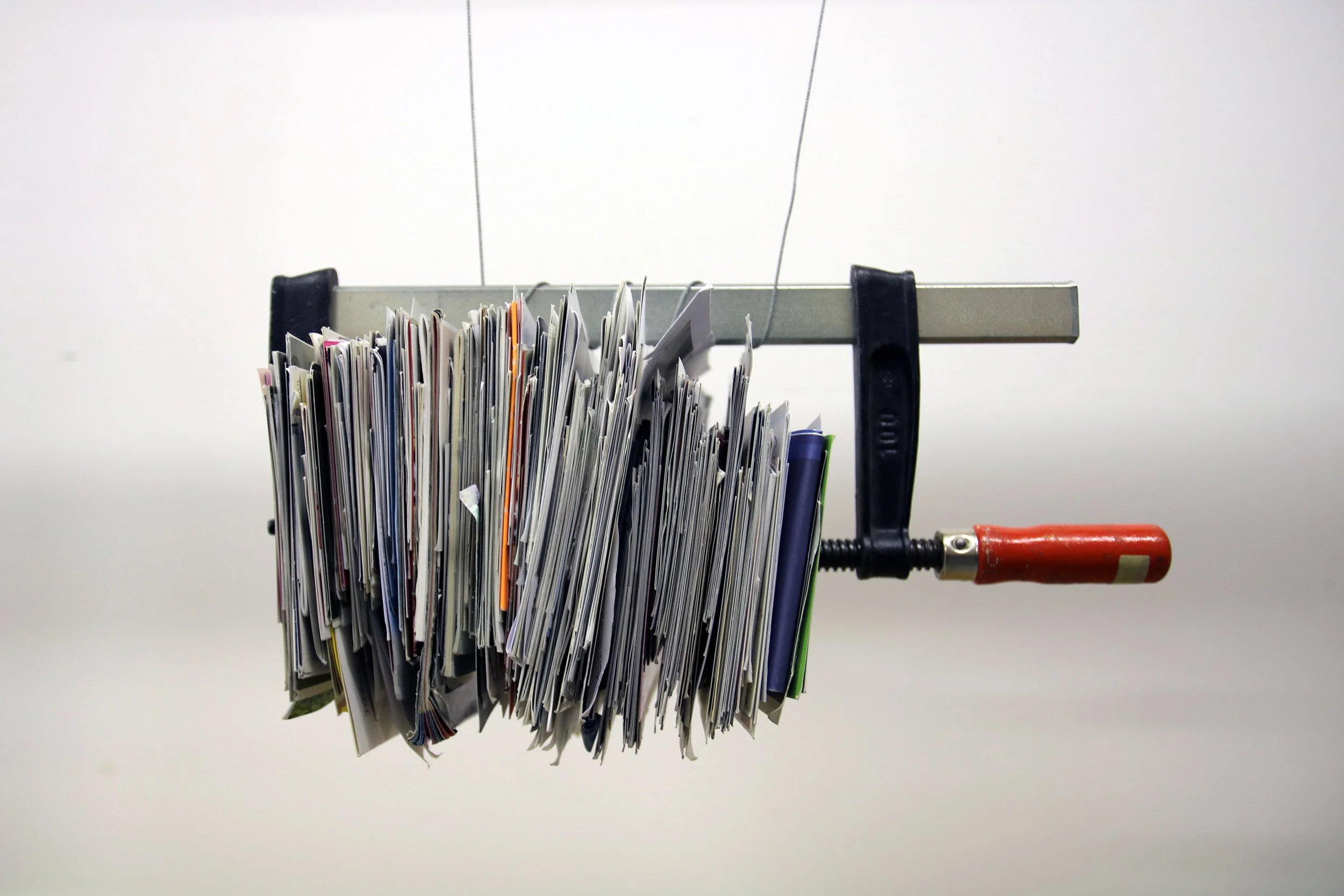proximity · pleasure · plasticity
looking at performance
Chukwudubem Ukaigwe, Deanna Peters/Mutable Subject,
demi-mesure (Clara Cousineau + Marion Paquette), Every Ocean Hughes, Francisco González-Rosas, Freya Björg Olafson, Hannah Wilke, Ivetta Sunyoung Kang, Lisa Smolkin, Manoushka Larouche, NIC Kay and Wan Yi Leung
From April 21 to June 23, 2022
Opening on April 21 at 6 pm*
Facebook event
Everyday, within a single, simultaneous beat, we both consume and produce images, whether for the camera or not. In a culture where identity is performative and spectacle is the baseline, how we look remains critical: look, as in how one appears before others, and look as in a way to witness. The works presented in this exhibition performatively treat the surface of the body as though it were an image and the surface of the image as though it were a body. This closeness, this touch, and this mattering are thus considered through the interconnected cluster of terms including proximity, pleasure, and plasticity.
Complicating sight lines, the artists ask, “who is seeing, who is seen... how, and what else?” They deploy different proximities: peripheral, inside, distant, repeated, delegated, blurred, absent, refused. Less concerned with the gaze of the camera and its domination, the artists consider non-dualistic relationships between the body and the image. Their performances are both a protest and a celebration of visibility.
There is a pleasure to such tension that intensifies the work’s potential to instigate ways of seeing and doing differently. This pleasure is in itself a kind of proximity, often distancing itself from the minimalist or authenticity-seeking modes of some performance art. Pleasure self-appropriates the labor of performance, renegotiating the terms of exchange in favor of new, curious definitions of ‘real’ in the midst of today’s ever-expanding, all-consuming imagescape.
Many of the works in the exhibition explore properties of the virtual self and digital image, how people mirror them, become them, and multiply them. Here, plasticity can be characterized as the changeability of the materialities by which the self takes shape, as well as the possibility that the self is an active shape maker. It is an assertion of mass and matter, involving how we relate to, and how we position ourselves with the world around us. Considering the now omnipresent interchangeability of image and self, these works have been brought together on the premise that we are as much of images as images are of us.
A project developed by Emma-Kate Guimond, under the direction of France Choinière.
-
In The Shivering, the image is host and witness to an intimacy between camera and subject. There is a felt sense of trust and friendship between the artist and his participants, all of whom are his friends, who like the artist, are young men of African descent. Ukaigwe choreographs a stillness into the frame that, by virtue of the video's temporality, accumulates vulnerability. The men sit, posed, before an extended and plural audience, privy to a confluence of perceptions regarding their identity. As they return the gaze, anticipating and perhaps even apprehending an unseen viewer, the image is blurred by a shaking that mirrors the fragility of their experience.
Chukwudubem Ukaigwe (b.1995) is an artist, curator, writer, and cultural worker based in Treaty 1 Territory in so-called Canada. Using a variety of mediums to explore plurality, he views his art practice as a conversation, or an ongoing exchange between creation and interpretation. He has participated in residencies in Winnipeg with Video Pool Media Arts Centre, Plug In Institute of Contemporary Art, and window, and was Artist-in-Residence for 2021’s Salt Spring Island Residency. He is also the founder of Patterns Collective, an online artist collective which operates on a de-colonial framework, and serves as the current editor of Plug In Editions Online.
-
Originally presented as a Livestream performance, Something between my face and your face is always interesting attempts to create situations for perceivability in the virtual distance between the performer and the audience. Presumably, both the performer and the audience are staring at their screens in the solitude of their own homes. As parts of Peters’ body disappear into a dark background, the viewer’s screen becomes a shifting black mirror. Because the performance was recorded on a laptop, the image and sound quality is consumer-grade — and in so, quotidian. Likewise, the pacing of the performance can be characterized as a kind of hangout time (she smokes a joint, bobs her head to music). It resists the imperative of productivity underwritten by the teleconferencing software employed, and that ultimately consolidates our identity and the capital we produce or become when interacting on the Internet.
Deanna Peters/Mutable Subject (b.1980) is a dance-based artist and designer living in Musqueam, Squamish and Tsleil-Waututh territories (Vancouver). They often curate, choreograph, and produce performances for DIY venues and online spaces. They hold a BFA in Fine Arts from Simon Fraser University (Burnaby), and they have completed residencies at 8 Days VI (Toronto), LEÑA Artist Residency (Galiano Island), Plastic Orchid Factory (Calgary), What Lab (Vancouver), and many more.
Something between my face and your face is always interesting features music by Ahmed Khalil.
-
Two protagonists appear as both copies and variations of each other. Through work-like choreography, they build, change and elaborate the visual environment that envelopes them. Highly aestheticized, this environment is also an image, a reflection of these figures where the materials, colors, and textures are extensions of their subjectivity. While this performance set could be described as decorative, the tangential relationships between forms — the way they touch or don’t touch — give rise to a certain pleasure, a combination of excitement and satisfaction. In this devout practice of form-making, the artists make their statement by combining the self with labor.
demi-mesure is a collaborative entity between Clara Cousineau (b.1994) and Marion Paquette (b.1992). Their work takes a multidisciplinary approach, combining sculpture, performance and video documentation. Working with both oppositional and complementary forms, the duo poetically and playfully explores the potential of the “in-between.” demi-mesure’s works have been presented at Espace Transmission (Montréal), OFFTA (Montréal), La Bande Vidéo (Québec City) and Fol Film Festival (Paris).
-
Filmed at Sergels Torg, a public square in Stockholm where the city’s political protests take place, Sense and Sense brings into relationship everyday body movement and the movement that initiates political change. As is in many of their works, Every Ocean Hughes appropriates the site collaboratively and improvisationally. Here, they enlist the performance artist MPA who responds to the task of “walking on her side”, laboriously inching the surface of her body against the pavement. The camera, initially creating an illusion that she is walking upright by using a close-up birds eye view, zooms out to reveal the immense scale of the site — showing the distance the performer has yet to traverse. As her horizontal body moves precariously in contrast to upright and casual walkers, the stakes of such movement are revealed. At the same time, the artist activates notions of impossibility as a way to shape and articulate an imaginary in which alternate ways of seeing and doing might be made possible.
Every Ocean Hughes (b.1977), f.k.a. Emily Roydson, is a transdisciplinary artist and writer, whose work addresses themes of queerness, gender, pleasure, and sustainable change. In 2002, they co-founded the queer feminist journal and artist collective, Lesbians To The Rescue (LTTR), along with Ginger Brooks Takahashi and K8 Hardy. Hughes' solo exhibitions have been shown at Studio Voltaire (London), Kunsthalle Lissabon (Lisbon), Secession (Vienna), PARTICIPANT INC and Art in General (New York), among others. Their solo show, Alive Time, was recently shown at Moderna Museet (Stockholm). They have also written lyrics for musicians The Knife, Colin Self, JD Samson, and designed costumes for choreographers Levi Gonzalez, Vanessa Anspaugh, Faye Driscoll, and Le Tigre. Currently, Hugues is the Sachs Visiting Professor at the University of Pennsylvania.
-
Through a roster of augmented and technological interfaces for body imaging, Identity templates for a disordered body addresses identity through rehearsals of self-seeing. Opening with a staged interview of a drag-like persona, meticulously decorated with an array of viral fad references, the work then segues into the production of a plastic 3D print made from scanning the artist’s body. Literally objectified and rendered into data, the artist uses the 3D modeling software as a kind of endoscope to look around inside this fleshless version of himself. Such multiplicity of forms are a means by which González-Rosas iterates otherness and the semiotic economy in which it plays out as thresholds of consumption, satiation, and resistance.
Francisco González-Rosas (b.1984) is a performance and new media artist born in Chile, and currently based in Tiohtià:ke/Montréal. His creative research practice revolves around the constant mediation of reality in contemporary life, using performance as a generative device for inquiry rather than an end in itself. González-Rosas holds a MFA in Intermedia from Concordia University (Montréal), and a BA in Acting from Finis Terrae University (Santiago). His video performance, Dating for Export, was acquired by the Musée d’art contemporain de Montréal for its permanent collection in June 2021.
-
CPA (Consistent Partial Attention) involves a video and movement score in which the artist reperforms found Internet videos of people dancing for the camera in their homes. Attempting to both see and do the dance, Olafson’s eyes consistently return to look down at a computer acting as both the screen and the camera. In spite of the identity-concealing digital effect applied to the “originals,” the people in the videos appear to move through textures of sensuality, theatricality, and fantasy. Their choice to broadcast these dances seems to reveal that having someone watching is necessary to their process of self-making. Olafson responds amicably by hosting their dances in her own body. She becomes an embodied interface for the source movement and its duplication, reflecting on the pathways of circulation and multiplication which occur when sharing images of ourselves.
Freya Björg Olafson (b.1983) is an intermedia artist who works with video, audio, animation, motion capture, XR, painting, and performance. Their praxis engages with identity and the body, as informed by technology and the Internet. Olafson’s work has been exhibited and performed internationally at the Bauhaus-Archiv (Berlin), Southeastern Center for Contemporary Art (North Carolina), Ludwig Museum (Budapest), and The National Arts Center (Ottawa), and in 2020, they were nominated as one of the longlist Sobey Art Award recipients. Olafson holds an MFA in New Media from the Transart Institute for Creative Research/Donau University Krems. Currently, they are an Assistant Professor in Digital Media at The School of Art at the University of Manitoba.
-
So Help Me Hannah started as a series of “performalist” photographs of Wilke posing nude, wearing only heels, and holding a small pistol. Overlayed with short phrases quoted from male artists and thinkers, the images theorize the/her body in relation to systems of representation and the art economy, while working to turn vulnerability and eroticism into vectors of knowledge. As a performance, So Help Me Hannah was performed a number of times from 1978 to 1985 and involved on-stage cameras for whom Wilke performed slow gestural movement that acted as a series of poses in continuum. Always aware of her image in relation to the camera’s physical presence and representational capacity, she exploits the gaze to perform an embodied critique, shifting the conditions of its operation. Through the accompanying soundscape of television advertisements layered with a spoken text, again composed of quotations, she further raises the stakes in a male-dominated arena of ideas and frustrates conventional modes of seeing.
Hannah Wilke (1940-1993) is a conceptual feminist artist whose work spans sculpture, drawing, photography, performance, and video. Her radical self-portraiture challenges prevailing representations of the female body. Her first institutional exhibition, Hannah Wilke, Scarification Photographs and Videotapes (1975) was held at the University of California's Fine Arts Gallery. Other notable solo exhibitions have been held at P.S.1 (New York), Washington Project for the Arts, Nikolaj Kunsthal (Copenhagen), and NgBk (Berlin). Wilke’s works have been acquired by the collections of the Guggenheim and the Whitney Museum of American Art (New York), the Centre Pompidou (Paris), and the Tate Modern (London), amongst numerous others. Her last series Intra-venus (1992-1993), was exhibited at multiple international galleries. In 2022, the Pulitzer Arts Foundation presented the major retrospective Hannah Wilke: Art for Life’s Sake (Missouri).
Courtesy of Electronic Arts Intermix (EAI) (New York).
-
In Proposition 1: Hands Ivetta Sunyoung Kang borrows from a Korean children’s game called “Make Electricity Happen,” offering a score for two people to exchange in a co-facilitated sensory exploration. Shifting from instruction to narration, the detail with which the text describes sensations, such as the coldness of the hand, attributes poetic meaning to the gestures. Arising sensations can be designated as both the viewer’s and a disembodied other’s. The camera’s focus on the hands, shifting only once to the face of a subject briefly sucking their own finger, adds to this ambiguity. An experiential mix of pleasure and proximity, the work also playfully ponders who, where, and what is seeing, doing, and feeling?
Ivetta Sunyoung Kang (b.1986) is a first-generation South Korean interdisciplinary artist based in Tiohtià:ke/Montréal and Tkaronto/Toronto. Through performance, text, and video, she explores the intersection of diaspora and mental illness, seeking care by unsettling colonial frameworks of oppression. Kang holds a BFA in Film Production at Sangmyung University (Seoul) and an MFA in Studio Arts from Concordia University (Montréal). Her works have been internationally presented at JEONJU International Film Festival, at Leonard and Bina Ellen Art Gallery and MAI (Montréal), Arlington Arts Center, Xpace Cultural Centre (Toronto), among others. She is currently publishing a selection of poems called Tenderhands, and is a co-founding member of Quite Ourselves, an artist collective seeking sustainable mobility in life/art creation.
-
In Life’s lil Bitch, Lisa Smolkin foregrounds the pleasure of color, friends, and learning as a strategy for surviving late capitalism’s social matrixes. As the protagonist of the narrative, she toggles between 3D avatar and video versions of herself, each time donning a remarkable lineup of fashion pieces. Traveling through similarly shifting, often fantastic visual landscapes, Smolkin analyzes and embodies a bombardment of anxieties including ancestral trauma, human developmental issues, and the lack of upward mobility. Inside a digital rendering of her own nervous system (one of the body’s main sites for metabolizing and reacting to stress), Smolkin hits the button to “proceed in a new way,” suggesting that within this enmeshment contains the possibility to reshape personal and collective narratives.
Lisa Smolkin (b.1972) is a performance, video, and installation artist living in Tkaronto/Toronto. Often using a satirical, yet vulnerable tone to explore themes of selfhood and the effect of social hierarchies, she combines elements of pop culture with healing processes in her work. She was a regular performer at Doored, a Toronto-based performance art/conceptual comedy show organized and hosted by the artist duo Life of a Craphead. Smolkin has performed at the Art Gallery of Ontario (Toronto), The Banff Centre for Arts and Creativity, Hamilton Art Gallery, and for the Toronto Biennial of Art among many others, and has had her work featured in Canadian Art and C Magazine.
Life’s lil Bitch includes collaborations with Liz Brain (Hannah Guinan and Alex Van Helvoort) with their opening musical track, Alisson Escobar who created the 3D avatar, and Zak Tatham who contributed to the video work.
-
Détail sur le visage reconnu [Detail on the recognized face] activates two possible readings of the word recognition as a way to consider the relationship between subjectivity and being seen. First, recognition implies appreciation: the artist claps her hands repetitively in front of her face. In other words, she applauds. Through duration and repetition, the inherent meaning of the gesture drifts. Recognition becomes more a matter of identification as Larouche’s movement creates the illusion of a blur effect, deteriorating the viewer's ability to recognize her. Since blur normally corresponds to the aperture of the camera, or is applied in editing thereafter, there is a sense that the boundary between the subject and the image — its surface — has been ruptured.
Manoushka Larouche (b.1990) is an interdisciplinary artist based in Tiohtià:ke/Montréal whose work is situated at the intersection of photography, writing, and the performativity which is essential to identity formation. She holds a BFA, as well as an MFA in visual and media arts from the Université du Québec à Montréal, and has had her work presented at Galerie UQO (Gatineau), CIRCA art actuel (Montréal), and in venues such as local E6-21 (Montréal), and Artexte (Montréal).
-
brown shades of Black and Wait, Wait, Wait are part of NIC Kay's broader project, #blackpeopledancingontheinternet. The project explores how Black online communities claim the Internet as a space for visible, culturally coded play, political organization, and innovation.
In brown shades of Black, the frame is filled with a sequence of changing shades of brown, contrasted with sound clips taken from videos thematically engaging with Black dance sonically on the Internet. Similarly, in the video Wait, Wait, Wait, the most repetitive lyrics of K Camp's song Lottery (Renegade) are extracted and emphasized in a written and sonic breakdown.
In 2019, a clip of the song Lottery (Renegade) was used by Jalaiah Harmon to choreograph The Renegade, which became the most influential viral dance trend in the US in recent years.
NIC Kay (b. 1989) is an American interdisciplinary artist and performer who works with movement to explore relationality and yearning, using choreography to excavate relationships between spaces, bodies, and objects, and to shift meaning and change perceptions of place. They are a Black queer trans non-binary person. They have performed internationally, including at Akademie der Künste (Berlin), Buddies in Bad Times Theatre (Toronto), Encuentro 19 (Mexico City), Institute of Contemporary Arts (London), Portland Institute for Contemporary Art, and Zurich University of the Arts. Kay was the recipient of the Dorothea Tanning Award from the Foundation for Contemporary Arts (New York) in 2020. They published their first book, Cotton Dreams, with Candor Arts in 2020.
-
Alone with the cat in the room documents the artist Wan Yi Leung beating an anonymous man in a dark room. Having met through the online dating network SugarDaddies, advertised as “the place where you can be completely honest about who you are and what you want,” they agree that she will beat him three times a week for three months. But without this out-of-frame information, the relationship between the artist and the participant elicits curiosities concerning power, transaction, and pleasure: who is working for who? As the artist looks directly at the camera, and by extension, the viewer, she challenges potential assumptions about her control of, and her role in the image.
Wan Yi Leung (b.1989) is a videographer and photographer who often documents her “strange encounters,” which respond to themes of gender-based power dynamics, fetishism and uncertainty, using ASMR triggers and エログロ (eroguro, the combination of eroticism/beauty and grotesqueness). Before obtaining her MFA in studio photography in 2021 at Concordia University (Montréal), Leung worked as a model in Berlin and London. Her work has been shown in Montréal at the Leonard and Bina Ellen Art Gallery, Peripheral Hours, Darling Foundry, and more.
Events
Session 30: Francisco-Fernando Granados in conversation with Margaret Dragu
On May 12, 2022 at 6 pm
Premiere on Facebook
Performances
Laurence Beaudoin Morin
+
Camille Rojas
On May 19, 2022 at 7 pm
Performance
Mathieu Lacroix
On June 4, 2022 from noon to 5 pm
Dazibao thanks the artists for their generous collaboration as well as its advisory programming committee for its support.
Dazibao receives financial support from the Conseil des arts et des lettres du Québec, the Canada Council for the Arts, the Conseil des arts de Montréal, the Ministère de la Culture et des Communications and the Ville de Montréal.
Dazibao acknowledges that we are located on unceded territory of the Kanien'kehá: ka Nation and that Tiohtiá: ke / Montreal is historically known as a gathering place for many First Nations, and today, is home to a diverse population of Indigenous as well as other peoples.

